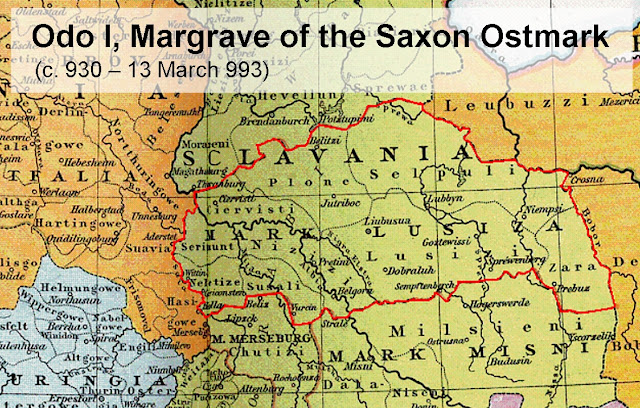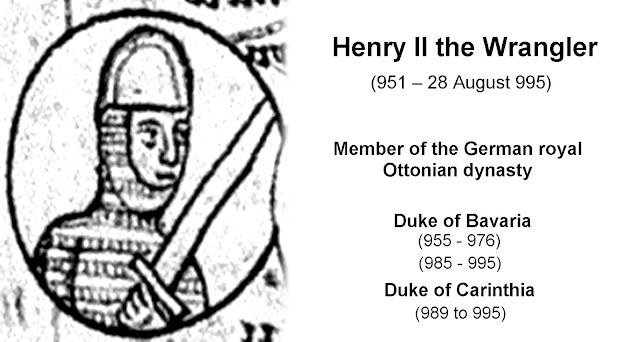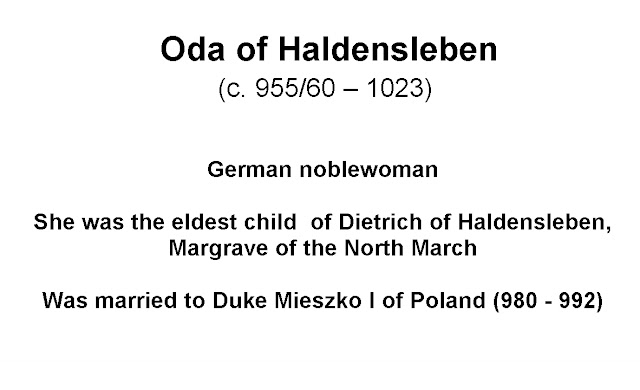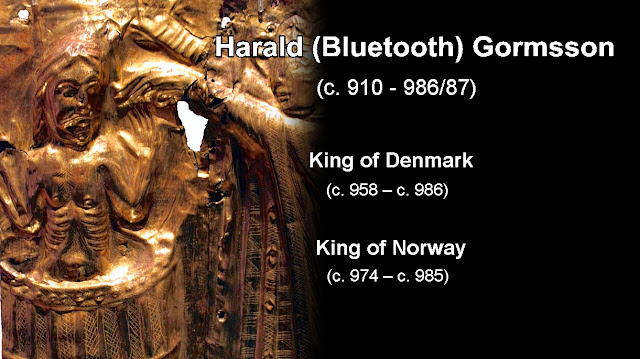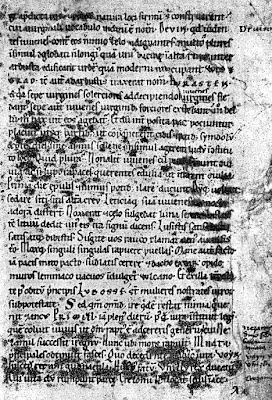Monday, April 10, 2023
Kingdom of Poland during the reign of Mieszko I
Mieszko I was the ruler of the Polans from about 960 until his death. A member of the Piast dynasty, he was a son of the legendary Siemomysł, and a grandson of Lestek.
Mieszko I took over the tribal rule after his father's death circa 950
– 960, probably closer to the latter date. Due to the lack of sources it is not possible to determine exactly which lands he inherited. Certainly among them were the areas inhabited by the Polans and
Goplans, as well as the Sieradz-Łęczyca lands and Kuyavia. It is possible that this state included also Masovia and Gdańsk Pomerania.
Soon the new ruler had faced the task of integrating the relatively large, ethnically and culturally heterogeneous territory. Although the residents of areas controlled by Mieszko spoke mostly one language, had similar beliefs and reached a similar level of economic and general development, they were socially connected primarily by tribal structures. It appears that the elders cooperating with the Duke first felt the need for super-tribal unity, as expansion allowed them to broaden their influence.
By the time Mieszko I took over from his father, the Polans' tribal federation of Greater Poland had for some time been actively expanding. Continuing this process, perhaps in the first years of
Mieszko's reign, if it had not been done already by his father, Mieszko I conquered Masovia. Likely also during that period or earlier, at least partially Gdańsk Pomerania was obtained.
In 963 the German Margrave Gero conquered territories occupied by the Polabian Lusatian and Słupian tribes, and as a result came into direct contact with the Polish state. Mieszko decided to pay
tribute to the Holy Roman Emperor in order to avoid an invasion similar to the one that Lusatia had suffered. This homage would take place in 965, or in 966 at the latest. Very likely the tribute applied only to the Lubusz land, which was in the German sphere of influence. This understanding of the tribute issue explains why already in 967 Mieszko I was described in the Saxon chronicles as the Emperor's friend, or ally.
Probably in 964 Mieszko began negotiations with the Bohemian ruler Boleslav I. As a result, in 965 Mieszko I married his daughter Dobrawa.
The next step was the baptism of Mieszko. It is assumed that it was a political decision, intended to bring Mieszko's state closer to the Czechs and to facilitate his activities in the Polabian Slavs area. At
the same time, the baptism decreased the likelihood of future attacks by German margraves and deprived them of the opportunity to attempt Roman Catholicization of Mieszko's lands by force. An additional reason could be Mieszko's desire to remove from power
the influential pagan priest class, who may have been blocking his efforts to establish a more centralized rule. It is generally recognized that the baptism of Mieszko I took place in 966.
Through the adoption of Catholicism, Mieszko I included his Polish state in the European community of Roman Catholic states. Consequently, neither the Holy Roman Empire nor any other Catholic country could invade Poland for the purpose of Christianizing the region, and Poland could now assert its right to be treated like other Christian states.
After the normalization of relations with the Holy Roman Empire and Bohemia, Mieszko I returned to his plans of conquest of the more western part of Pomerania. On 21 September 967 the Polish-
Bohemian troops prevailed in the decisive battle against the Wolinians led by Wichmann the Younger, which gave Mieszko the control over the mouth of the Odra River.
In 972 Poland suffered the attack of Odo I, Margrave of the Saxon Ostmark. According to the chronicles of Thietmar, this attack was an arbitrary action, without the consent of the Emperor. Odo's forces moved in and on 24 June 972 twice engaged Mieszko's army at the village of Cidini, commonly identified with Cedynia. At first, the Margrave defeated Mieszko's forces, but the Duke's brother, Czcibor defeated the Germans in the decisive stage, inflicting great
losses among their troops. It may be that Mieszko intentionally staged the retreat, which was followed by a surprise attack on the flank of the German pursuing troops. It is believed that in practical terms the victory at Cedynia sealed Western Pomerania's fate as Mieszko' dependency.
According to archaeological research, during the 970s the Sandomierz region and the Przemyśl area inhabited by the Lendians became incorporated into the Polish state. None of it is certain for the lack of written sources.
After the death of Emperor Otto the first in 973 Mieszko, like his brother-in-law, Duke Boleslav II of Bohemia, joined the German opposition in support of the attempted imperial succession of Henry
II, Duke of Bavaria. The Duke of Bavaria was defeated, and Emperor Otto the second regained full power. Shortly afterwards, the young emperor waged a retaliatory expedition against Bohemia, in 978 forcing Duke Boleslav into submission.
In 977 Mieszko's wife, Dobrawa, died. At first there were no apparent repercussions, as the Polish ruler had maintained his alliance with Bohemia. In 979 Otto II supposedly attacked Poland. The effects of this expedition are unknown, but it is suspected that the Emperor did not succeed. Due to bad weather, the Emperor was back at the border of Thuringia and Saxony in December of that year.
The Polish-German agreement was concluded in the spring or possibly summer of 980. It appears that during this time Mieszko
the first married Oda, daughter of Dietrich of Haldensleben, Margrave of the Northern March. The marriage with Oda considerably affected the position and prestige of Mieszko, who entered the world of Saxon aristocracy. As a son-in-law of
Margrave Dietrich, he gained an ally in one of the most influential politicians of the Holy Roman Empire. As the Margrave was a distant relative of the Emperor, Mieszko became a member of the circle connected to the imperial ruling house.
Probably in the early 980s Mieszko allied his country with Sweden against Denmark. The alliance was sealed with the marriage of Mieszko's daughter Świętosława with the Swedish king Erik.
Mieszko decided on the alliance with Sweden probably in order to help protect his possessions in Pomerania from the Danish King Harald Bluetooth and his son Sweyn. The Danish were defeated ca. 991 and their ruler was expelled.
The death of Otto II at the end of 983 created unrest in the Holy Roman Empire. The Emperor left a minor successor, Otto III. The
right to care for him and the regency powers were claimed by Henry the second of Bavaria. Like in 973, Mieszko and the Czech duke Boleslav the second took the side of the Bavarian duke. In 984 the Czechs took over Meissen, but in the same year Henry the second gave up his pretension to the German throne. The role played by Mieszko the first in the subsequent struggles is unclear because the contemporary sources are scarce and not in agreement. Probably in 985 the Polish ruler ended his support for the Bavarian duke and moved to the side of the Emperor. In 986 the Polish ruler had a personal meeting with the Emperor, an event mentioned in the Annals of Hersfeld. The meeting consolidated the Polish-German alliance, with Mieszko joining Otto's expedition against a Slavic land, which together they wholly devastated. It is not clear which Slavic territory was invaded, but probably was an expedition against the Czechs.
Whether or not the German-Polish invasion of Bohemia actually happened, the friendly relations between the Czechs and the Poles came to an end. Bohemia resumed its earlier alliance with the Lutici, which caused in 990 a war with Mieszko, who was supported by Empress Theophanu. Duke Boleslav II was probably the first one to attack. As a result of the conflict, Silesia was taken over by Poland. However, the annexation of Silesia possibly took place around 985, because during this year the major Piast strongholds in Wrocław, Opole and Głogów were already being built.
The issue of the incorporation of Lesser Poland is also not completely resolved. Possibly Mieszko took the region before 990, which is indicated by the vague remark of Thietmar, who wrote of a country taken by Mieszko from Boleslav. Some historians, on the basis of the chronicle of Cosmas of Prague, believe that the conquest of the lands around the lower Vistula River took place after Mieszko's death, specifically in 999.
During his last years of life Mieszko remained loyal to the alliance with the Holy Roman Empire. Mieszko died on 25 May 992. Sources give no reasons to believe that his death occurred from causes other than natural. The remains of the first historical ruler of Poland have never been found and the place of his burial is not known with certainty.









